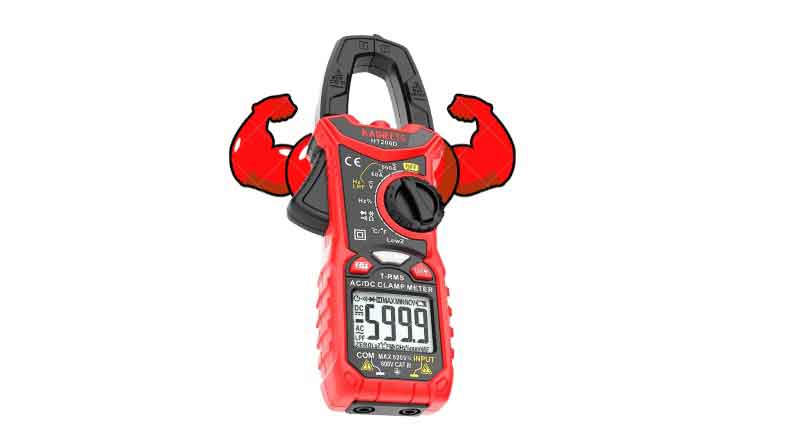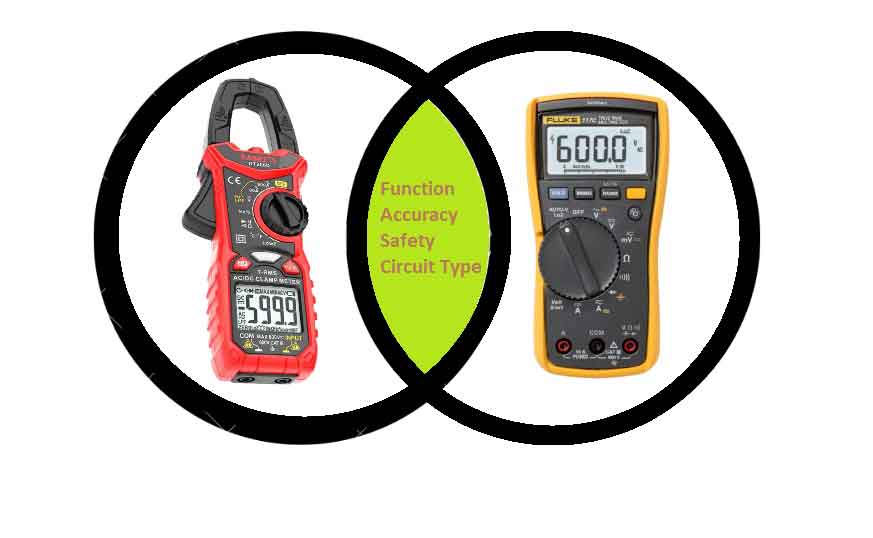Each instrument is designed for a special task. Likewise, clamp meters and multimeters are quite different instruments with different modes of measurement and applications.
Hence, it does not mean that these two instruments compete. Each of them is equally important. They cannot replace each other, although designers are trying to do so.
For a starter, a clamp meter operates through a non-invasive method, designed for only measuring current, measuring high current, and electricians love it. Meanwhile, a multimeter works through the invasive method, measures approximately all electrical parameters, has a large resolution, and is an ideal instrument for research purposes.
However, this blog will tell users about the basic difference between clamp meters and multimeters.
What is the Difference Between a Clamp Meter and a Multimeter?
The working principles, applications, results, accuracy, method, and physique of both are different from each other.
There is always the quest for an instrument to perform all functions. However, this is still a quest till the publishing date of this article.
The Difference Between a Clamp Meter and a Multimeter
The key difference between a clamp meter and a multimeter is its mode of operation. The clamp meter measures current without disturbing the circuit, and the circuit is functional at the same time.
For the multimeter, we break the circuit and connect it in series with circuit components to measure current.
Clamp Meters Verses Multimeters
Let us compare both to understand the main differences between them. These are the differences between a simple clamp meter and a simple multimeter. We are ignoring the auxiliary functions at this stage.

1. Purpose of Usage
Clamp meters are only designed for measuring current in live circuits. Modern clamp meters can also measure other electrical parameters, but this is optional, not basic.
Multimeters measure all electrical parameters like voltage, current, resistance, etc. This is the only purpose of its design to calculate these parameters. Thus, it performs more tasks than a clamp meter.
2. Mode of Operation
Clamp meters do not physically or electrically connect with the circuit to measure the value of current. They use the phenomenon of electromagnetic induction to sense current.
Meanwhile, multimeters connect physically and electrically with the corresponding circuit and follow the laws of electricity.
3. Method of Operation
Clamp meters get the value of current without disturbing the main circuit. For this purpose, the circuit must be live. This method is commonly known as a non-invasive method.
On the other hand, if we are using a multimeter for measuring current, we will break the circuit and connect the multimeter in series like other components. For this purpose, we must stop the normal operation of the circuit.
This method is called the invasive method.
4. Applications
A clamp meter is used by electricians for measuring current in high-volt AC. This not only measures the value of current, but also makes them safe during operation. Engineers use it for monitoring purposes only.
Multimeters are more like research tools. Engineers use this in low-voltage operation and circuit design. Nowadays, smart multimeters are replacing old-fashioned multimeters in these applications.
5. Safety
It is obvious from our discussion that the clamp meter is safer than the multimeter while dealing with high voltage and current. We are bold enough to say that clamp meters are best for dangerous circuits.
However, when it comes to accuracy in low voltages, the multimeter takes first place.
6. Physique
Clamp meters are generally used by electricians for repairing, troubleshooting, and diagnosis. Hence, the workplace for an electrician is temporary and rough. Thus, a clamp meter is designed tough and durable.

Unlikely, multimeters do not bear tough conditions. It is known as a “Lab Tool” by professionals. It does not need to be tough like a clamp meter.
These were some key differences between clamp meters and multimeters. Let’s study how these two instruments play the same role in workplaces.
Similarities Between Clamp Meters and Multimeters
Besides differences, there are similarities between clamp meters and multimeters. They can also be used interchangeably in many cases.
Some technologically advanced clamp meters can replace low-tech multimeters in many fields.

The function and working of the clamp meter and multimeter intersect in the following areas:
1. Functions
Nowadays, the clamp meter is not limited to only measuring current. Many relevant functions have been installed to complete multimeters. In the following table, we have concluded these functions.
| Measuring Functions | Clamp meter (Available) | Multimeter (Available) |
| Current | Yes | Yes |
| Voltage | Yes | Yes |
| Resistance | Yes | Yes |
| Capacitance | Yes | Yes |
| Frequency | Yes | Yes |
| Temperature | Yes | Yes |
| NCVT | Yes | Yes |
| Diode Testing | Yes | Yes |
| Connectivity Test | Yes | Yes |
Here, it is worth mentioning that the availability of these functions is not common in every clamp meter or multimeter. These are limited to some brands.
2. Accuracy
We have a sort of confusion regarding the low accuracy of clamp meters. This is true for only some unauthentic brands. We have highly accurate clamp meters in the market, manufactured by popular brands.
These clamp meters can compete with multimeters in accuracy, if not superseded.
Similarly, multimeters have been best for high voltages, like clamp meters. However, there are specific brands that designed these clamp meters.
3. Safety
As we know clamp meters are safer to operate than multimeters in high voltages. The non-invasive method made us able to measure current safely and accurately.
Likewise, with proper knowledge, a multimeter can also be operated safely. The safety categories mentioned on these multimeters tell us their capability of safety.
4. Circuit Type
We have analog and digital types of circuits in clamp meters as well as multimeters. Each has its importance. However, the digital model of both is considered accurate and durable.
Even extra safety is installed to make the circuit more safe. This extra care made these internal circuits more reliable and durable for every type of condition in workplaces.
Conclusion
The clamp meter and multimeter are important instruments for electrical and electronics engineers. Each has its advantages over others.
However, there are specific areas where we can use only clamp meters and vice versa. The basic differences between clamp meters and multimeters are recognizable from their use.
We use clamp meters for high voltages and high current circuits. While multimeters are good for low voltages. Here, the accuracy is not meticulously considered.
The mode of operation is different for both. Clamp meters do not connect electrically and work on electromagnetic induction. It is the opposite of a multimeter.
The clamp meter works on a non-invasive method and measures only current safely. On the other hand, multimeters measure all electrical parameters through invasive methods.
A clamp meter needs to be tougher than a multimeter due to its usage in the outer workplace. Meanwhile, a multimeter is more like a tool for researchers and designers.
Besides all these differences, modern clamp meters can easily compete with multimeters in functions, accuracy, safety, and circuitry efficiency. However, this statement is not common for all clamp meters.
Other useful posts:
